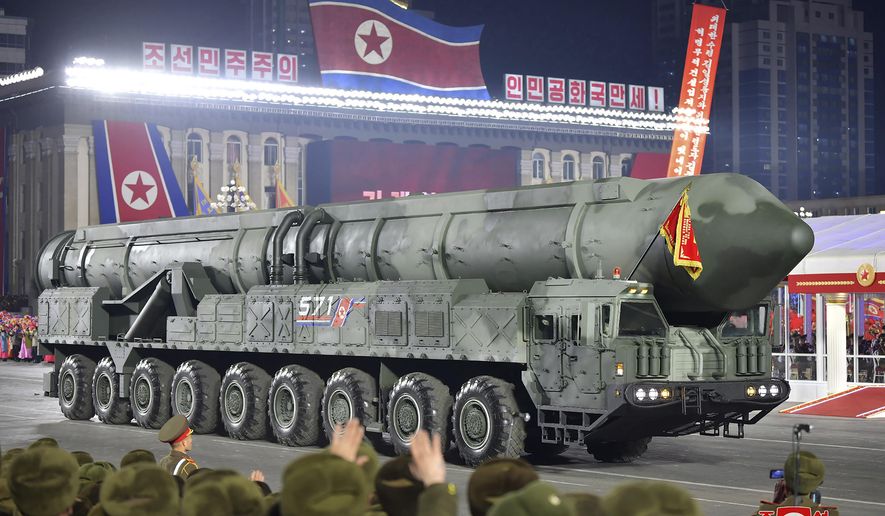North Korea’s parade of 11 intercontinental ballistic missiles through the streets of Pyongyang last week put on display a force that analysts say is capable of overwhelming the systems that the U.S. military has put up to defend the homeland.
While North Korea’s military progress raises strategic questions, it also raises one of economics: How is the world’s richest country vulnerable to an impoverished state with an isolated, backward economy that ranks 135th in the world in national wealth?
Political will is clearly one answer. Kim Jong-un, head of the North Korean regime, has made weapons development a focal economic priority. “For the strengthening and development of our armed forces, let us all double our efforts and do more for the prosperous development of the socialist motherland,” Mr. Kim said at a banquet last week, according to state media reports.
North Korea became even more economically isolated after closing its borders to prevent the spread of COVID-19. How it received the hard currency needed to underwrite the research, manufacture and deployment of its massive, nuclear-armed hardware is still in question.
Part of the answer, South Korean officials and analysts say, is a specialized corps of online hackers who last year clandestinely brought in $1.7 billion to $2 billion to finance North Korea’s military-industrial complex.
“There are many different departments in North Korea that send [abroad] IT workers, and many of these organizations are listed under U.N. sanctions for [weapons of mass destruction] procurement,” said Chai Kyung-hoon, director of the North Korean Nuclear Policy Division of the South Korean Ministry of Foreign Affairs.
SEE ALSO: North Korean missile display puts U.S., allies on notice
“What we are finding is these IT workers are playing an integral role in providing funds and procuring materials and components for nuclear missile development,” Mr. Chai said Thursday at a conference in Seoul about state threats in cyberspace.
Joint international efforts to choke off this money supply are just now getting off the ground, analysts say.
Kim’s pricey arsenal
At North Korea’s Eighth Party Congress in January 2021, Mr. Kim laid out a wish list of weapons so ambitious that outside analysts gasped.
Key items included a “super-large” hydrogen bomb, tactical nuclear devices, mid- and long-range cruise missiles, anti-aircraft missiles, heavy tanks, multiple-warhead missiles, “hypersonic gliding flight warheads,” long-range drones, reconnaissance satellites and the country’s first nuclear submarine.
North Korea had conducted no nuclear tests since 2017 but abruptly stepped up the pace of weapons activity last year. Pyongyang staged more tests of multiple classes of missiles and drones in one year than ever before. The tests included ICBMs, ballistic missiles with variable flight paths, long-range cruise missiles and various tactical weapons, including long-range multiple rocket systems, or MLRS.
While stiff-arming the Biden administration’s offers of direct talks, Pyongyang has conducted only one missile test so far this year. Yet the midnight parade Wednesday showed that Mr. Kim is ticking off the items on his list.
Analysis of photos of the parade that ran in South Korean media outlets suggested that, in addition to the 11 ICBMs, the North Korean military had put on display mock-ups of the first solid-fuel ICBMs in development by Pyongyang. Also mounted on specialized vehicles were 240 mm MLRS, tactical guided missiles and what were believed to be new cruise missiles, along with a new tank.
The impressive and expensive display again raised questions about where the Kim regime was getting the money to pull it off.
The U.S. Treasury’s “2021 Military Expenditures and Arms Transfers” report estimated that North Korea spends $4 billion annually on its military, about 26% of its gross domestic product.
No other power comes close. According to the latest numbers from the World Bank, China spends 1.7% of GDP on its military, South Korea spends 2.8%, the U.S. 3.5%, Russia 4.1% and Israel 5.2%.
To ease the burden that arms development places on its national economy, North Korea is acquiring extranational funds. The favored method is theft, carried out by a dedicated corps of cyberoperatives.
Low visibility, high reward
The pilfering in cyberspace is not new. In 2016, North Korean hackers stole $81 million from the Bangladesh Bank. In 2017, their “WannaCry” attack infected computers in 150 countries with ransomware.
More recent operations have been especially low-visibility, high-reward. The leading target is the murky, lightly regulated world of cryptocurrencies.
“North Korea’s operatives, using keyboards rather than guns, stealing digital wallets of cryptocurrency instead of sacks of cash, are the world’s leading bank robbers,” the Justice Department charged in a 2021 indictment of three North Korean programmers.
The operatives work in two ways, Mr. Chai said at the Seoul conference.
One is through heists of cryptocurrencies, which he estimated generated $1.7 billion for Pyongyang last year. The second is through the export of workers to global information technology forms who earn “hundreds of millions of dollars” in hard currency by creating apps and cryptocurrency-related products.
Though the internet is borderless, the operatives deploy overseas to acquire the skills, network access and foreign currencies they need. They operate in countries such as China, Cambodia, China, Malaysia, Thailand and Vietnam.
Thae Yong-ho, a North Korean defector and South Korean parliamentarian, told foreign reporters this month that North Korean IT candidates receive four years of specialized education before moving abroad to take jobs under assumed identities.
“When you develop games or programs, there are no borders or barriers,” Mr. Thae said. “So it is very difficult to verify the identities of IT workers.”
Once employed, the IT workers purchase software and hone network infiltration techniques, Mr. Thae said. North Koreans are secretly working for Indian, Japanese, South Korean and U.S.-owned companies, he said.
Some operatives establish their own companies, often in Southeast Asia, with the mission of carrying out direct hacking and cybertheft operations.
Fighting back
Belated countermoves to cut off North Korea’s funding spigots are underway.
South Korea and the U.S. last year established a joint working group that combined law enforcement, intelligence, defense and finance experts to address the North’s financing channels. The group generated “a list of concrete actions” to take, Mr. Chai said, though he gave no details.
British MI5 and South Korean cybersecurity authorities are cooperating, and the South Korean National Intelligence Service last year joined the NATO Cooperative Cyber Defense Center of Excellence.
While Western partners bring advanced techniques and technologies, South Korea can share lessons learned from painful experiences.
“We have been attacked by the North a lot, so we have learned lessons and information, and we can share this,” said Oh Il-sook, a cybersecurity expert at Seoul’s Institute for National Security Strategy. “We can show the characteristics of North Korean technologies and attacks.”
• Andrew Salmon can be reached at asalmon@washingtontimes.com.




Please read our comment policy before commenting.